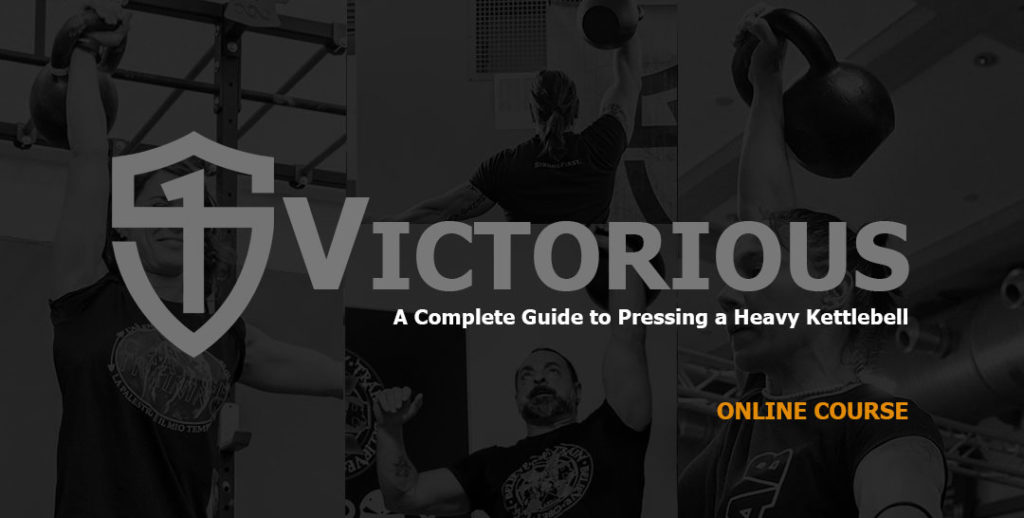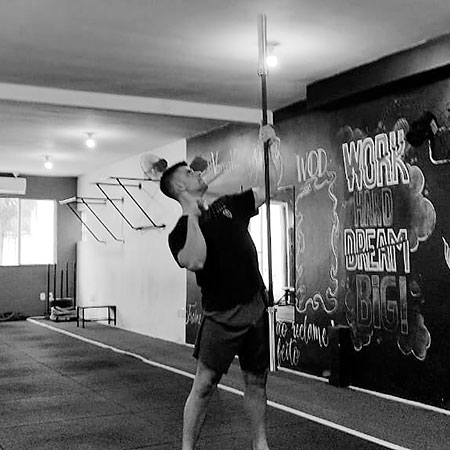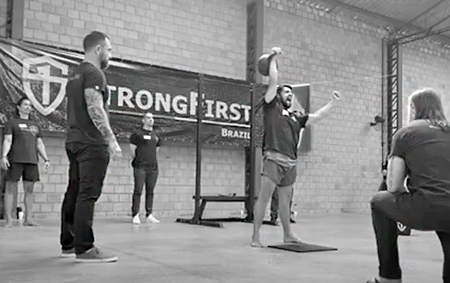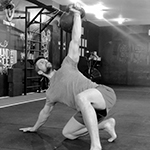I’ve always been the kind of person who likes competition and challenges. And events in my life usually happen at an interesting time (mostly late). I became interested in Kung Fu at fifteen. When I was twenty-two, I started playing volleyball. At thirty-one I picked up a kettlebell for the first time and at thirty-six I became a Beast Tamer. But obviously, things didn’t go as linearly as I describe.
Over the ten years of my Kung Fu training, I can say that I became an expert at seeking intensity, but I had never periodized anything in relation to my training. Like my master always said, “When you’re tired, push a little. Then when it starts to hurt, hold on a little longer. Then when you can’t take it anymore, do twenty more repetitions.”
Something similar happened when I started strength training to improve my performance on the volleyball court. One day I went with my wife to the gym. She was preparing for the SFG Level I Certification at the time. When her trainer saw me working out, he commented, “There’s a closeted Beast Tamer.” We had a few laughs and I clearly remember him saying, “You would be very strong if you could train.” I confess I didn’t like hearing that, but it was the spark that ignited my desire to take up the Beast Tamer challenge. I can say now with complete certainty that up to that point, I had only worked out—never trained.
The Journey to Beast Tamer
But life is not a fairy tale. Five years and some health problems later, I started my journey to Beast Tamer. In January 2021, I started working with the same coach who trained my wife. I signed up for the SFL Certification and planned to do the challenge during that weekend. Having already done StrongFirst kettlebell and barbell workshops, I knew some StrongFirst material. When I began training, my Beast Tamer lifts were:
- One-arm kettlebell military press: 40kg
- Tactical pullup: 28kg
- Pistol squat: 48kg
The start of our training together also came with some issues. This part of the story is worth noting: all my years of non-periodized training had contributed to a meniscus operation and a lumbar hernia.
The Problem
After nine months of training with my coach, I began training and programming on my own. I was still far from pressing the Beast (48kg kettlebell). I was having trouble initiating the press with the 44kg kettlebell. I was able to rack it but as I began the movement it would roll, or I would lose tension. I was stuck at 40kg. I was able to do four repetitions with 40kg but not one with 44kg. It was frustrating.
I decided to take the VICTORIOUS online course by StrongFirst Certified Master Instructor, Fabio Zonin, and that’s when things changed. From a solid foundation, I was able to understand the importance of the correct order of pre-activation from the GLAG-P sequence: Grip, Lats, Abdominals, Glutes, and finally Press.

About one month later focusing only on this technique, the 44kg went up. But it still wasn’t solid enough to try the 48kg.
Let’s pause for a little analysis.
Considering my many years of martial arts and knowing the importance of having strong hands, fists, and forearms—I came to the conclusion that I was not making good use of mine. I analyzed my press step-by-step and concluded that the Statue of Liberty drill, developed by Fabio Zonin, could be my ally.
During this drill, the student must perform an ulnar deviation increasing the activation by irradiation of the forearm and triceps, which results in greater strength production. Essentially, raising the kettlebell like a torch.
I began incorporating this into my training and then one day, I had an idea.
The Idea
I took a barbell from the squat rack and held it standing—like a spear. At first, it felt uncomfortable. I tried to push the barbell in a similar pattern to a kettlebell press, which was not possible. But eventually, I figured out an effective way to use it in my training. Below I will describe the drill that grew from this idea. This drill is for anyone who wants to develop their heavy press technique.
Now I give you, the spear drill.
The Spear
Imagine that the barbell is a spear, and you must lift it and “stick” it to the ceiling. Your fist will be flexed in an ulnar deviation, like Fabio’s torch, but you’ll press holding the bar upright.
First, place the barbell near you resting on the floor in front of your chest with your hand at chest height—exactly like the kettlebell rack. Then lower the height of the handgrip in order to increase the activation of the lats. Initiate the pre-activation sequence: Grip, Lats, Abdominals, Glutes, and then start your press.
After a few weeks of training the spear drill, I reached some conclusions. The lower the handgrip on the bar, the more tension you will generate and the harder it will be to perform, especially at the very beginning of the movement. But this is good because the increased difficulty will bring your hip drive into play. With this lower hand position, place the bar, set your grip, and run the GLAG sequence but before you press, shift your hip to the side of the bar.
Precautions
Be aware of your surroundings when you do this drill. Pay attention to the height of your space to avoid breaking lamps or damaging ceilings. Notice where your feet are because the “spear” will return to the ground after the press is completed. Know exactly where the landing site of the bar will be.
Using and Specializing the Spear Drill
Finally, if your fist is sore, especially in the area between the thumb and the beginning of the radius, this is a serious indication that your local strength may not be suitable for the bar you are using. In this case use a 15kg bar to start, or even a 10kg bar.
Another suggestion is to use the assisted Band Pull-Press drill to help you, also developed by Fabio. Tie a band around a fixed bar or a rig. Let it hang down near your free hand. The moment you fire your press, pull the band. This will help the bar rise and increase the activation of the unloaded side, creating more stability in the movement.
Another option is to use a clubbell in place of the bar or even do only the eccentric phase of the movement. In this second example, raise the bar with both hands, position yourself correctly, as if you were in the lockout position, and then enjoy the descent with one hand—keeping a maximum amount of tension in the body to take advantage of this phase.
You can use this drill in two ways:
- Movement preparation for the kettlebell press
- A main drill to enhance your press strength according to your needs
Here’s how I used it.
The Program
High volume days
- 1-3 sets of 2 to 4 reps with a 15kg bar before pressing a kettlebell
Remember the idea is to engage and activate the muscles used in the press (hands, wrists, forearms, triceps, and back), polishing the movement and preparing you for more work with the kettlebell.
Low volume days
- 3-6 series of 1 or 2 reps max (as the main work of the day) with a 20kg bar.
If you’d like to use an even heavier bar, you can add small weights to increase the load, but be sure to take a good amount of rest between sets. I used a reasonably heavy load because the intent was to increase neural stimulus and the ability to generate muscle tension, as well as the quality of the electrical signal. This caused an improvement in my movement pattern and increased the quality of force production. Below you will find the format of my weekly kettlebell military press volume paired with the spear drill.
Monday
- One-arm kettlebell press: 30-45 reps per side divided into 4 zones, ranging from 60% of your one-rep max (1RM) to 90% 1RM
- Spear drill: 1×4, 1×3, and 1×2 with the 15kg bar
Wednesday
- One-arm kettlebell press: 20-30 reps per side divided into 3 zones ranging from 70% 1RM to 92.5% 1RM
Friday
- Spear Drill: 3×2 and 3×1 with 20kg bar
- One-arm kettlebell press: 15-20 reps per side divided into 3 zones ranging from 55% 1RM to 75% 1RM
Now, back to the Beast Tamer preparation.
After discovering the spear drill, I used it twice a week and gradually improved my technique in the heaviest areas of the press. The certification was rescheduled twice in 2021, which gave me more time to develop and use the spear drill.

Some other things to consider were my training schedule and injuries throughout my preparation. Only my wife and I work at our gym, V2 Centro de Treinamento, and my training schedule was often from 9:00 a.m.-11:00 p.m. Sometimes technical errors occurred due to tiredness causing inflammation in my elbow, plantar fasciitis, a lumbar hernia, and neural impingement.
These injuries made me physically unable to train due to pain, and I had to resort to extreme medications.
Sometimes you must take a step back to go forward two.
January 2022, a year after starting my preparation, I had to make some critical decisions with only three months until the SFL Certification in March. I decided to review my training volume, as well as all my planning. I included more technical routines and relied on a wavier periodization. After all my best pullup and press were still only with 44kg. Something needed to change.
I put together one last strength program that was solely focused on the press and pullup. I decreased the frequency of the basics to once a week and started focusing on other aspects such as improving sleep quality, nutrition, and reducing daily stress. I was very happy with these decisions.
In early March, I decided to retest. My press and my pullup went up—so did my pistol squat. It was an exciting day. I spent the remaining time completing a simple routine, maintaining good stimuli, and preparing for the certification.
Considering all the events involved leading up to the SFL Certification, I had a lot of anticipation. I tested all three movements one more time before I challenged the Beast Tamer and felt confident going into the weekend. Due to the nervousness of the moment, my press was not quite as I expected, but in the end everything went well. The Beast Tamer challenge was tamed.

Final Thoughts
The spear drill has changed the way I approach the kettlebell military press. Completing it requires hand, fist, and forearm strength and has helped increase my body awareness during the press. Making good use of your strength requires practice, technique, and time. And I can assure you that this drill will deliver.
Here’s a suggestion for those who want to venture towards a heavy military press—use the spear drill. You can start with a light bar assisted by elastic bands, a dumbbell, or revisit the variations I mentioned above. Explore the movement. I’m sure you’ll like the results. Not only in terms of increasing your pressing load, but the improvement of your overall pressing technique.
Remember, respect your adaptation time. Growth is not always linear. I found that heavy training was not always beneficial and that my best movements did not occur on days I “felt” rested. Overall, my most valuable lessons did not come from my best training sessions. Challenge yourself. You’ll like it—or at least you’ll get to get to know yourself better.


